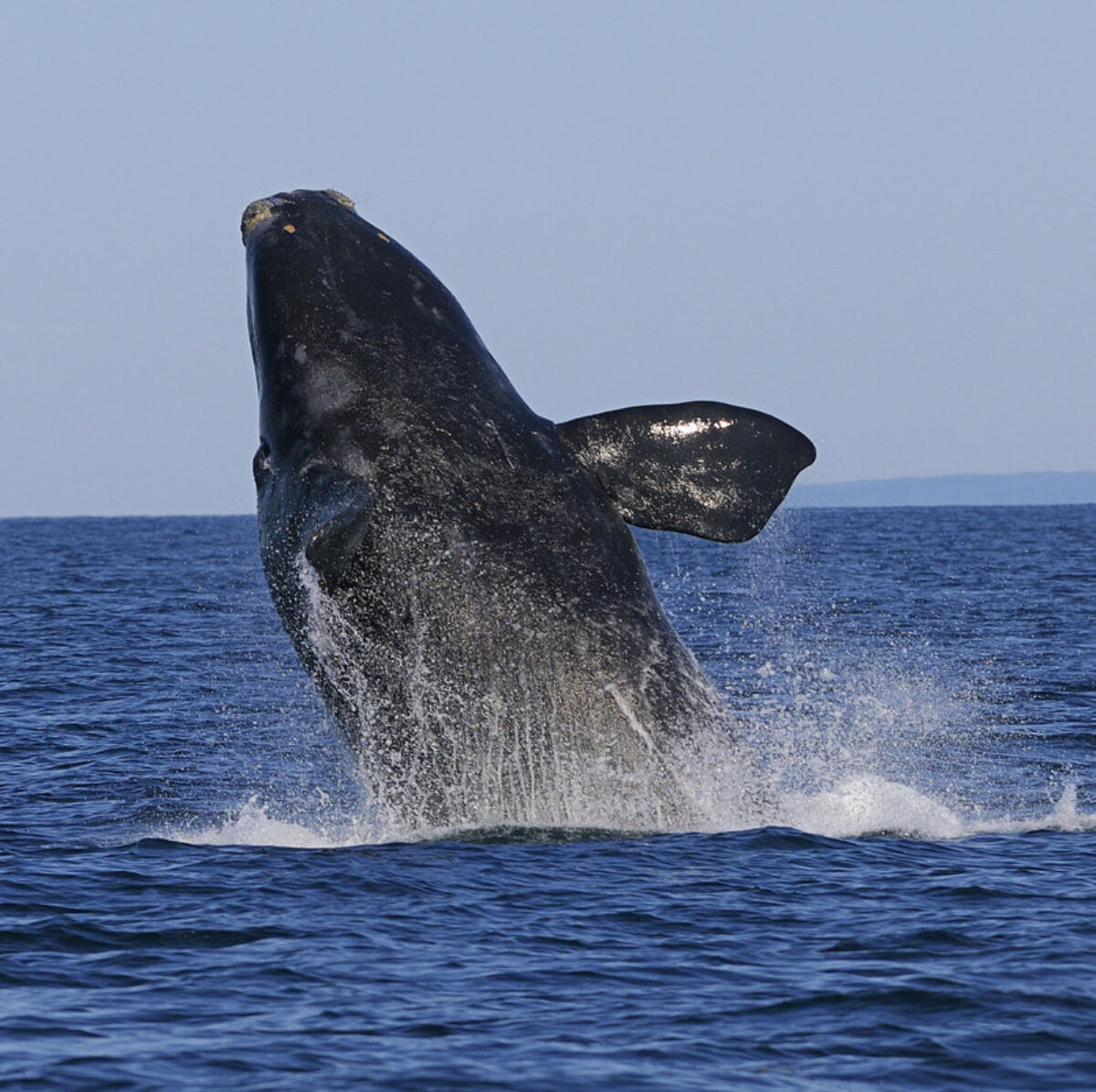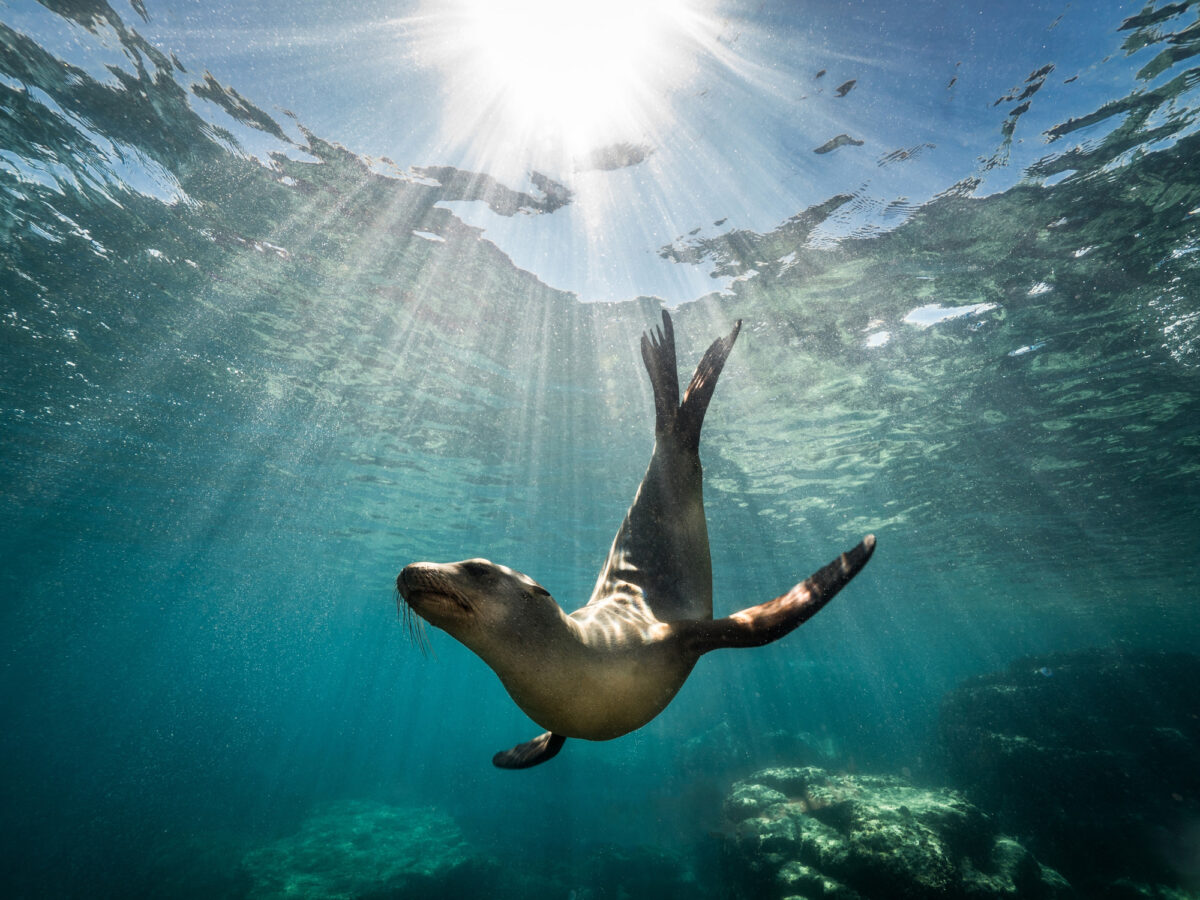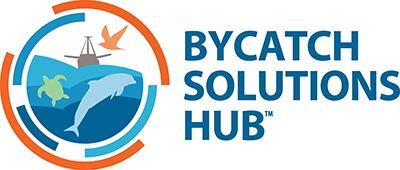Bycatch species
Marine Mammals
The marine mammals most impacted by fisheries are the whales and dolphins (cetaceans) and seals and sea lions (pinnipeds).
In the past, many of these species were hunted for meat, blubber, skins, and oils which led to high rates of overexploitation.
In modern times the greatest threat to many marine mammal species is bycatch in fisheries. For whales and dolphins, entanglement in fishing gear is the greatest cause of annual mortality with over 300,000 killed each year in fishing nets, particularly gill nets. This occurs in both large commercial and artisanal, small-scale fisheries.
What happens to marine mammals if caught or entangled?

North Atlantic Right Whale, breaching.
In addition to net fisheries, the large baleen whales are also highly susceptible to injury and death from buoy lines in submersible net and pot/trap fisheries. Large whales can become entangled in these lines, which typically run vertically in the water column from the bottom to the surface, and drag the gear for weeks to months, and potentially for years. Buoy lines are often caught within their mouths where they become lodged in the baleen and prevent whales from being able to feed. If entanglement occurs around the fins or head, the line often cuts into the flesh causing large lacerations that can become infected and in general overall decrease in body condition. Entanglements around the fins can also make swimming difficult for these large animals.
Seals, sea lions, and walruses are often caught in trawl and gillnet fisheries targeting demersal and mid-water fishes in temperate seas.
Removal of marine mammals has negative impacts on the ecosystem

Sea lion
The removal of marine mammals has been shown to impact marine environments by removing both top-down (predation) and bottom-up (nutrient cycling) processes.
- Dolphins, seals, sea lions, sea otters, and polar bears are large-body predators that influence the behavior of smaller fish and crustaceans and contribute substantially to the stability of an ecosystem.
- Large baleen whales turn large plankton blooms into nutrients through digestive processes and move large amounts of energy and nutrients from temperate to tropical environments through their large-scale migrations.
- Dugongs and manatees are prolific grazers that shape tropical sea grass habitats and provide an environment for other organisms to settle and grow, many which are juveniles for commercially important fishery species.
Fishery Impacts
- Avoid fishing in hotspots, areas known to have large abundances of marine mammals.
- Adopt move-on rules (move to new location to set) when interaction with marine mammals occur and fleet communication to inform other vessels.
- Provide best methods handling and release training to the captain and crew.
- Require 100% coverage on all fishing vessels, combination of human observer and electronic monitoring, with detailed bycatch data collection.
- Ensure 100% compliance with all management measures specific to marine mammals, both at the country and management organization level.
- Fully restrict setting nets around marine mammals and whale sharks.
- Use best practices when marine mammals are encircled in the net to allow escape before hauling onto the deck, for example the back down method and Medina panel.
- Require trackers on deployed FADs that provide accurate and reliable geolocation and identification information.
- Require the use of non-entanglement and biodegradeble FADs.
- Require 100% coverage on all fishing vessels, combination of human observer and electronic monitoring, with detailed bycatch data collection.
- Ensure 100% compliance with all management measures specific to marine mammals, both at the country and management organization level.
- Transition to alternative gear types effective for the target species.
- Restrict fishing in regions and times of the year with high bycatch rates.
- Limit the soak time of the gillnet to decrease time that bycatch is entangled.
- Deploy acoustic pingers regularly along the gillnet.
- Provide best methods handling and release training to the captain and crew.
- Require 100% coverage on all fishing vessels, combination of human observer and electronic monitoring, with detailed bycatch data collection.
- Ensure 100% compliance with all management measures specific to marine mammals, both at the country and management organization level.
- Restrict fishing in regions and times of the year when large whales migrate through or reside in fishing areas.
- Require a sophisticated gear marking system that will provide easy identification of the fishery and location of entangled gear.
- Support the development and implementation of ropeless systems and virtual gear marking technology.
- Ensure 100% compliance with all management measures specific to marine mammals, both at the country and management organization level
Longlines primarily impact toothed whales (dolphins and porpoises) that depredate on hooked fish and either become hooked or entangled in the branch line. In order to minimize serious injury, overly long set times (the amount of time the gear is allowed to soak in the water) need to be avoided and proper handling and release equipment needs to be onboard. It is important that the captain and crews are trained in the use of proper handling and release equipment and techniques. Once marine mammals are encountered, it is recommended to move to a new fishing area to avoid repeat interactions.
General Recommendations:
Impact
Historically, purse seines were set around schooling dolphins in the open ocean due to their overlap with targeted tuna species. This led to very high bycatch mortality rates for dolphins and porpoises in pelagic tuna purse seine fisheries. Current regulations greatly limit net sets around dolphin schools, however, they are still occasionally caught within purse seines and there are still some purse seine fisheries that set their nets around schools of dolphins and tuna. In order to decrease any mortality risk, it is important that fishers use best practices to allow marine mammals to escape from the net before it is brought on board such as the back down method and Medina panel.
Purse seine sets are now heavily concentrated around fish aggregating devices (FADs) which often use hanging ropes and nets which increase the amount of submersible material and increase aggregation rates of both targeted and non target species. However, these ropes and nets, which hang below the water column, can lead to marine mammal entanglement and death. In cases where FADs are lost adrift and cannot be recovered, they will continue to entangle marine life, and potentially marine mammals, until they sink or are finally recovered with can take years to decades.
General Recommendations
Impact
Marine mammals can become entangled in gillnets and eventually drown if they can’t surface for air. These fishing methods are non-selective and lead to very high levels of bycatch. They will catch nearly any creature that swims into them. While some size selection can be obtained through differences in the size of the mesh, effective mitigation methods have not proven to be as successful as in other fisheries. In addition, this can lead to large bycatch issues if large nets are lost and continue to ghost fish. Therefore, it is important that lost gear can be recovered which is possible by deploying tracking buoys on the net.
Gill nets will catch nearly any creature that swims into them.
Acoustic pingers and underwater lights have shown some promise in preliminary studies but the most effective practice to eliminate bycatch is through changes in fishing practices. The recommended practice is a transition to alternative gear types. Otherwise, best practices include setting the net lower in the water column, limiting soak times (nets hauled more often) and strong spatial and temporal closures should be enacted when bycatch risk is highest.
General Recommendations
Impact
Pots and traps typically require the use of buoy lines, ropes that run from the trap on the seafloor to a buoy on the surface that marks the location of the trap. Large baleen whales can swim into these buoy lines and get entangled. This often occurs in and around the mouth when feeding or around the fins. If entangled in and around the mouth, whales cannot feed and in combination to the extra drag created by the towed line, this can lead to rapid deterioration of body condition. In addition, constant rubbing from the buoy line can create deep lesions on the whale that combined with the poor body condition lead to death from malnutrition and disease.
Often times whales drag trap buoy lines for months before they are observed and the source of the fishing gear cannot always be identified. Therefore, it is important that gear marking allows for the identification from where and what fishery the gear came from in order to properly address the entanglement problem. Developments over the last two decades have led to ropes and links that will break at a certain pressure, designed to break when a whale begins to drag traps after becoming entangled. However, evidence that these weak ropes/links are effective if a whale actually becomes entangled is minimal and they do increase safety concerns to crew when hauling gear.
The best way to reduce risk to large whales is to remove buoy lines from the water.
The best way to reduce risk to large whales is to remove buoy lines from the water. Trials and early fishery implementation of ropeless (on-demand) systems have shown promise over the last five years. These systems only deploy buoy lines when hauling and therefore nearly remove all risk associated with buoy line entanglement. Current efforts should promote increased implementation of ropeless systems in pot/trap fisheries that overlap with large whales while supporting the development of gear marking capabilities so trap locations can be virtually marked and identified by fishers.
